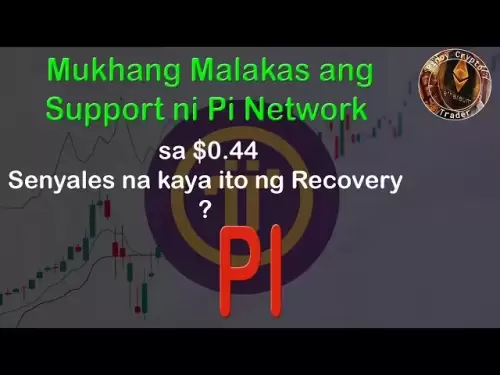-
 Bitcoin
Bitcoin $108,708.8110
0.60% -
 Ethereum
Ethereum $2,561.6057
1.91% -
 Tether USDt
Tether USDt $1.0001
-0.03% -
 XRP
XRP $2.2795
0.57% -
 BNB
BNB $662.2393
1.00% -
 Solana
Solana $153.1346
3.74% -
 USDC
USDC $1.0000
0.00% -
 TRON
TRON $0.2877
0.97% -
 Dogecoin
Dogecoin $0.1710
3.93% -
 Cardano
Cardano $0.5871
1.61% -
 Hyperliquid
Hyperliquid $39.6663
1.68% -
 Sui
Sui $2.9032
0.79% -
 Bitcoin Cash
Bitcoin Cash $496.1879
1.71% -
 Chainlink
Chainlink $13.5807
3.01% -
 UNUS SED LEO
UNUS SED LEO $9.0777
0.61% -
 Stellar
Stellar $0.2514
4.51% -
 Avalanche
Avalanche $18.1761
1.86% -
 Shiba Inu
Shiba Inu $0.0...01173
1.72% -
 Toncoin
Toncoin $2.8010
-4.23% -
 Hedera
Hedera $0.1594
3.21% -
 Litecoin
Litecoin $87.0257
-0.53% -
 Monero
Monero $319.1217
1.79% -
 Polkadot
Polkadot $3.3853
0.68% -
 Dai
Dai $0.9999
-0.01% -
 Ethena USDe
Ethena USDe $1.0003
0.02% -
 Bitget Token
Bitget Token $4.3420
-0.97% -
 Uniswap
Uniswap $7.3772
1.39% -
 Aave
Aave $286.6277
5.61% -
 Pepe
Pepe $0.0...09994
2.33% -
 Pi
Pi $0.4589
1.76%
Does UNI need to stop loss immediately when the TD sequence sell signal appears?
When a TD sequence sell signal appears on UNI, traders should consider market context and risk tolerance before deciding on an immediate stop loss.
Apr 25, 2025 at 08:49 am
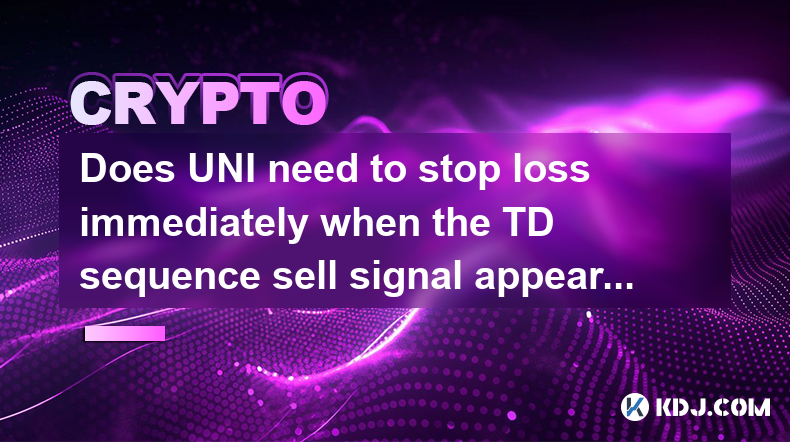
Does UNI need to stop loss immediately when the TD sequence sell signal appears?
The TD (Tom DeMark) sequence is a popular technical analysis tool used by traders to identify potential reversal points in the market. When it comes to the cryptocurrency UNI (Uniswap), traders often wonder if they should immediately execute a stop loss upon the appearance of a TD sequence sell signal. This article will delve into the intricacies of the TD sequence, its application to UNI, and whether an immediate stop loss is necessary when a sell signal is triggered.
Understanding the TD Sequence
The TD sequence, developed by Tom DeMark, is a method used to identify potential price exhaustion points in a market. It consists of two main components: the TD Setup and the TD Countdown. The TD Setup identifies the initial phase of a potential reversal, while the TD Countdown confirms the exhaustion of the current trend.
- TD Setup: This phase requires nine consecutive price bars where each bar's close is higher than the close four bars earlier for a buy setup, or lower for a sell setup.
- TD Countdown: After a valid TD Setup, the countdown begins. It requires 13 consecutive price bars where each bar's close meets specific criteria relative to the highs and lows of the previous bars.
Applying the TD Sequence to UNI
When trading UNI, understanding how the TD sequence applies can be crucial for making informed decisions. UNI's price volatility can make it particularly challenging to interpret these signals accurately.
- Identifying the TD Setup on UNI: Traders should look for nine consecutive candles on the UNI chart where the close of each candle is higher than the close four candles earlier for a buy setup, or lower for a sell setup.
- Confirming with the TD Countdown: Once the setup is complete, the countdown phase should be monitored. For UNI, this involves checking 13 consecutive candles to see if they meet the specific criteria for a confirmed sell signal.
The Importance of Context in TD Sequence Signals
While the TD sequence can provide valuable insights, context is crucial. The effectiveness of a TD sequence sell signal on UNI can vary based on several factors:
- Market Trends: If UNI is in a strong bullish trend, a TD sequence sell signal might be less reliable.
- Volume: High trading volume accompanying the signal can increase its validity.
- Other Indicators: Combining the TD sequence with other technical indicators, such as moving averages or RSI, can provide a more comprehensive view.
Immediate Stop Loss: Necessary or Not?
The question of whether to execute an immediate stop loss upon a TD sequence sell signal on UNI depends on several considerations:
- Risk Tolerance: Traders with a lower risk tolerance might prefer to execute a stop loss immediately to protect their capital.
- Confirmation: Waiting for additional confirmation from other indicators or a break below a key support level might be more suitable for traders who are willing to take on more risk.
- Position Size: The size of the position in UNI can also influence the decision. Larger positions might warrant a more cautious approach.
Executing a Stop Loss on UNI
If a trader decides to execute a stop loss upon a TD sequence sell signal, here are the steps to follow:
- Identify the Signal: Confirm that the TD sequence sell signal is valid on the UNI chart.
- Set the Stop Loss Level: Determine an appropriate stop loss level based on the recent price action and support levels.
- Execute the Order: Place a stop loss order on your trading platform at the predetermined level.
Here is a detailed guide on how to set a stop loss on a typical trading platform:
- Open your trading platform: Navigate to the section where you can manage your open positions.
- Select the UNI position: Find the specific UNI trade you wish to set a stop loss for.
- Access the order settings: Click on the trade to open the settings or modify order options.
- Set the stop loss price: Enter the price at which you want the stop loss to trigger. This should be based on your analysis of the TD sequence sell signal and other relevant factors.
- Confirm the order: Double-check the stop loss level and confirm the order. Ensure that the stop loss is set correctly and will execute automatically if the price reaches that level.
Combining TD Sequence with Other Tools
To enhance the reliability of TD sequence signals on UNI, traders often combine them with other technical analysis tools:
- Moving Averages: A bearish crossover of moving averages can reinforce a TD sequence sell signal.
- Relative Strength Index (RSI): An overbought RSI reading can add weight to a sell signal.
- Support and Resistance Levels: A break below a key support level can confirm the validity of a TD sequence sell signal.
Case Studies: TD Sequence on UNI
Examining past instances where the TD sequence was applied to UNI can provide valuable insights:
- Case Study 1: In early 2023, a TD sequence sell signal appeared on the UNI chart. Traders who immediately executed a stop loss avoided a subsequent 10% drop in price. However, those who waited for additional confirmation missed out on potential profits as the price rebounded shortly after.
- Case Study 2: Later in the same year, another TD sequence sell signal was triggered. This time, the signal was accompanied by high trading volume and a bearish RSI reading. Traders who acted on this signal and set a stop loss benefited from a timely exit before a significant price decline.
Practical Considerations for UNI Traders
When using the TD sequence to trade UNI, traders should consider the following practical aspects:
- Time Frame: The effectiveness of the TD sequence can vary depending on the time frame used. Shorter time frames may produce more signals but with less reliability, while longer time frames may offer more reliable signals but fewer trading opportunities.
- Backtesting: Before relying on the TD sequence for live trading, backtesting the strategy on historical UNI data can help traders understand its performance and refine their approach.
- Market Conditions: The overall market sentiment and conditions can impact the reliability of TD sequence signals. During periods of high volatility or significant news events, signals may be less reliable.
FAQs
Q1: Can the TD sequence be used effectively on other cryptocurrencies besides UNI?
Yes, the TD sequence can be applied to other cryptocurrencies. However, the effectiveness may vary depending on the specific characteristics and volatility of each cryptocurrency. Traders should backtest the strategy on historical data for each cryptocurrency to understand its performance.
Q2: How often should I check for TD sequence signals on UNI?
The frequency of checking for TD sequence signals depends on the time frame you are trading. For shorter time frames, such as hourly charts, you may need to check more frequently. For longer time frames, such as daily charts, checking once a day may be sufficient.
Q3: Are there any specific tools or platforms that are recommended for tracking TD sequence signals on UNI?
Several trading platforms and charting tools support the TD sequence, including TradingView and MetaTrader. These platforms allow you to customize indicators and set alerts for TD sequence signals, making it easier to monitor UNI's price action.
Q4: How can I improve the accuracy of TD sequence signals on UNI?
To improve the accuracy of TD sequence signals on UNI, consider the following strategies:
- Combine with other indicators: Use additional technical indicators like moving averages, RSI, and volume to confirm the signals.
- Backtest and refine: Regularly backtest your strategy on historical UNI data and refine your approach based on the results.
- Consider market context: Always take into account the broader market conditions and sentiment when interpreting TD sequence signals.
Disclaimer:info@kdj.com
The information provided is not trading advice. kdj.com does not assume any responsibility for any investments made based on the information provided in this article. Cryptocurrencies are highly volatile and it is highly recommended that you invest with caution after thorough research!
If you believe that the content used on this website infringes your copyright, please contact us immediately (info@kdj.com) and we will delete it promptly.
- Bitcoin, Jon Atack, and El Salvador: A Crypto Conundrum
- 2025-07-07 23:15:12
- Google, AI Chatbots, and Altcoins: Navigating the Shifting Sands of Search and Crypto
- 2025-07-07 23:15:12
- By Georgia:
- 2025-07-07 23:50:57
- Ethereum (ETH) Analyst Points: Is a Major Breakout Imminent?
- 2025-07-07 23:55:12
- BBVA's Crypto Leap: Bitcoin and Ethereum for the Masses?
- 2025-07-07 22:30:12
- Bitcoin, Strategy, and Windfalls: Decoding the Latest Moves
- 2025-07-07 22:30:12
Related knowledge
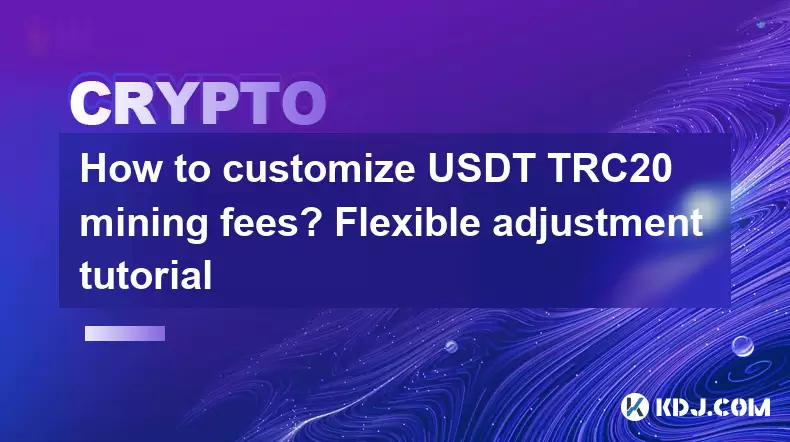
How to customize USDT TRC20 mining fees? Flexible adjustment tutorial
Jun 13,2025 at 01:42am
Understanding USDT TRC20 Mining FeesMining fees on the TRON (TRC20) network are essential for processing transactions. Unlike Bitcoin or Ethereum, where miners directly validate transactions, TRON uses a delegated proof-of-stake (DPoS) mechanism. However, users still need to pay bandwidth and energy fees, which are collectively referred to as 'mining fe...
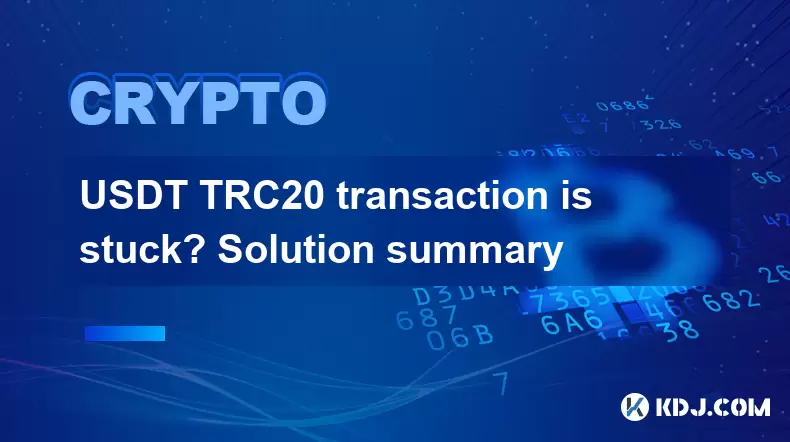
USDT TRC20 transaction is stuck? Solution summary
Jun 14,2025 at 11:15pm
Understanding USDT TRC20 TransactionsWhen users mention that a USDT TRC20 transaction is stuck, they typically refer to a situation where the transfer of Tether (USDT) on the TRON blockchain has not been confirmed for an extended period. This issue may arise due to various reasons such as network congestion, insufficient transaction fees, or wallet-rela...
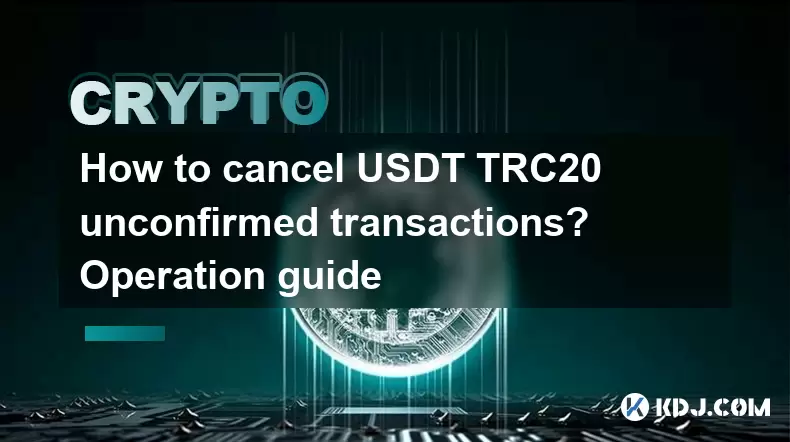
How to cancel USDT TRC20 unconfirmed transactions? Operation guide
Jun 13,2025 at 11:01pm
Understanding USDT TRC20 Unconfirmed TransactionsWhen dealing with USDT TRC20 transactions, it’s crucial to understand what an unconfirmed transaction means. An unconfirmed transaction is one that has been broadcasted to the blockchain network but hasn’t yet been included in a block. This typically occurs due to low transaction fees or network congestio...
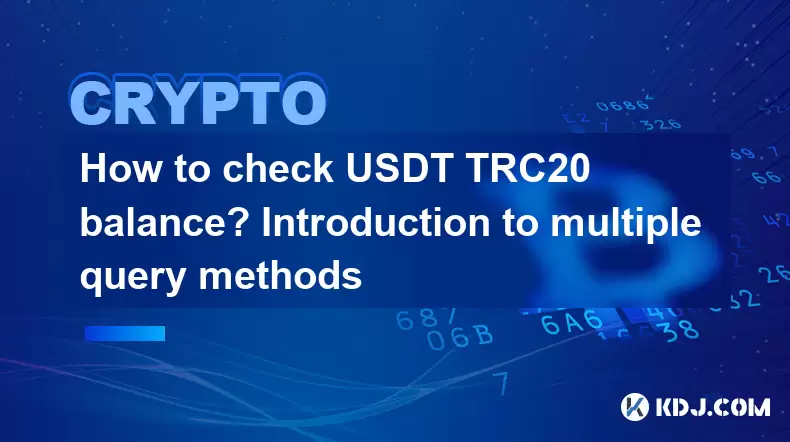
How to check USDT TRC20 balance? Introduction to multiple query methods
Jun 21,2025 at 02:42am
Understanding USDT TRC20 and Its ImportanceUSDT (Tether) is one of the most widely used stablecoins in the cryptocurrency market. It exists on multiple blockchain networks, including TRC20, which operates on the Tron (TRX) network. Checking your USDT TRC20 balance accurately is crucial for users who hold or transact with this asset. Whether you're sendi...
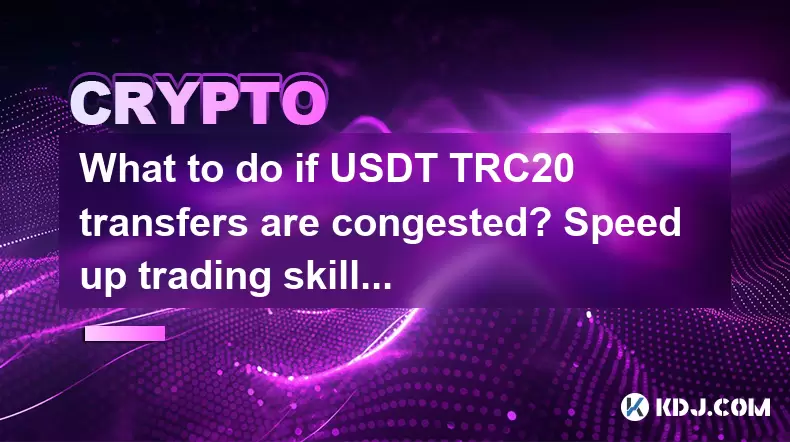
What to do if USDT TRC20 transfers are congested? Speed up trading skills
Jun 13,2025 at 09:56am
Understanding USDT TRC20 Transfer CongestionWhen transferring USDT TRC20, users may occasionally experience delays or congestion. This typically occurs due to network overload on the TRON blockchain, which hosts the TRC20 version of Tether. Unlike the ERC20 variant (which runs on Ethereum), TRC20 transactions are generally faster and cheaper, but during...
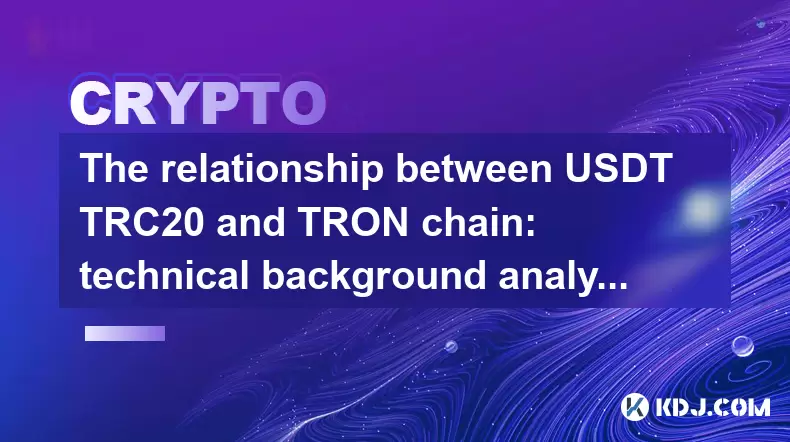
The relationship between USDT TRC20 and TRON chain: technical background analysis
Jun 12,2025 at 01:28pm
What is USDT TRC20?USDT TRC20 refers to the Tether (USDT) token issued on the TRON blockchain using the TRC-20 standard. Unlike the more commonly known ERC-20 version of USDT (which runs on Ethereum), the TRC-20 variant leverages the TRON network's infrastructure for faster and cheaper transactions. The emergence of this version came as part of Tether’s...

How to customize USDT TRC20 mining fees? Flexible adjustment tutorial
Jun 13,2025 at 01:42am
Understanding USDT TRC20 Mining FeesMining fees on the TRON (TRC20) network are essential for processing transactions. Unlike Bitcoin or Ethereum, where miners directly validate transactions, TRON uses a delegated proof-of-stake (DPoS) mechanism. However, users still need to pay bandwidth and energy fees, which are collectively referred to as 'mining fe...

USDT TRC20 transaction is stuck? Solution summary
Jun 14,2025 at 11:15pm
Understanding USDT TRC20 TransactionsWhen users mention that a USDT TRC20 transaction is stuck, they typically refer to a situation where the transfer of Tether (USDT) on the TRON blockchain has not been confirmed for an extended period. This issue may arise due to various reasons such as network congestion, insufficient transaction fees, or wallet-rela...

How to cancel USDT TRC20 unconfirmed transactions? Operation guide
Jun 13,2025 at 11:01pm
Understanding USDT TRC20 Unconfirmed TransactionsWhen dealing with USDT TRC20 transactions, it’s crucial to understand what an unconfirmed transaction means. An unconfirmed transaction is one that has been broadcasted to the blockchain network but hasn’t yet been included in a block. This typically occurs due to low transaction fees or network congestio...

How to check USDT TRC20 balance? Introduction to multiple query methods
Jun 21,2025 at 02:42am
Understanding USDT TRC20 and Its ImportanceUSDT (Tether) is one of the most widely used stablecoins in the cryptocurrency market. It exists on multiple blockchain networks, including TRC20, which operates on the Tron (TRX) network. Checking your USDT TRC20 balance accurately is crucial for users who hold or transact with this asset. Whether you're sendi...

What to do if USDT TRC20 transfers are congested? Speed up trading skills
Jun 13,2025 at 09:56am
Understanding USDT TRC20 Transfer CongestionWhen transferring USDT TRC20, users may occasionally experience delays or congestion. This typically occurs due to network overload on the TRON blockchain, which hosts the TRC20 version of Tether. Unlike the ERC20 variant (which runs on Ethereum), TRC20 transactions are generally faster and cheaper, but during...

The relationship between USDT TRC20 and TRON chain: technical background analysis
Jun 12,2025 at 01:28pm
What is USDT TRC20?USDT TRC20 refers to the Tether (USDT) token issued on the TRON blockchain using the TRC-20 standard. Unlike the more commonly known ERC-20 version of USDT (which runs on Ethereum), the TRC-20 variant leverages the TRON network's infrastructure for faster and cheaper transactions. The emergence of this version came as part of Tether’s...
See all articles























